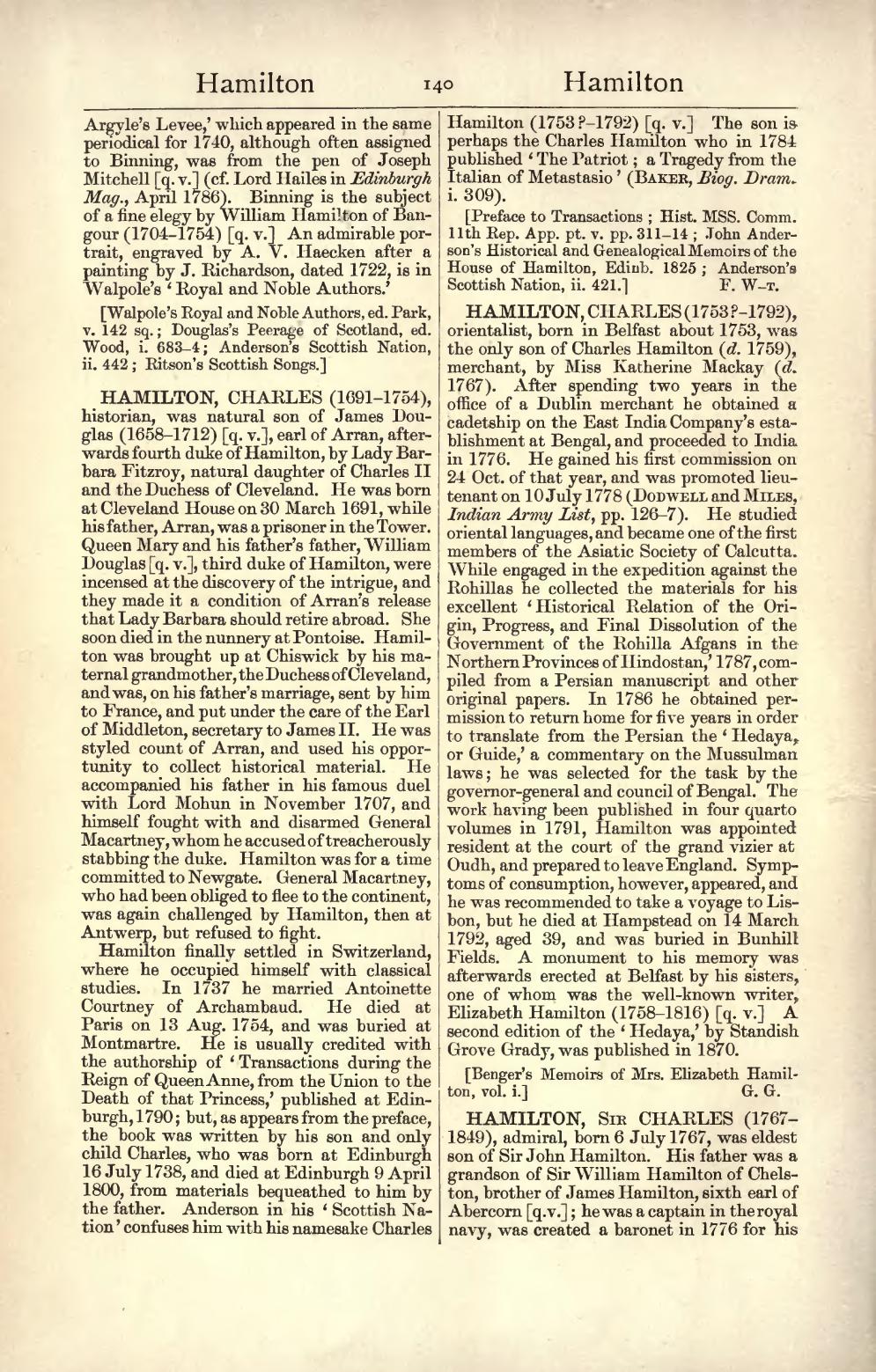Argyle's Levee,' which appeared in the same periodical for 1740, although often assigned to Binning, was from the pen of Joseph Mitchell [q. v.] (cf. Lord Hailes in Edinburgh Mag., April 1786). Binning is the subject of a fine elegy by William Hamilton of Bangour (1704–1754) [q. v.] An admirable portrait, engraved by A. V. Haecken after a painting by J. Richardson, dated 1722, is in Walpole's 'Royal and Noble Authors.'
[Walpole's Royal and Noble Authors, ed. Park, v. 142 sq.; Douglas's Peerage of Scotland, ed. Wood, i. 683-4; Anderson's Scottish Nation, ii. 442; Ritson's Scottish Songs.]
HAMILTON, CHARLES (1691–1754), historian, was natural son of James Douglas (1658–1712) [q. v.], earl of Arran, afterwards fourth duke of Hamilton, by Lady Barbara Fitzroy, natural daughter of Charles II and the Duchess of Cleveland. He was born at Cleveland House on 30 March 1691, while his father, Arran, was a prisoner in the Tower. Queen Mary and his father's father, William Douglas [q. v.], third duke of Hamilton, were incensed at the discovery of the intrigue, and they made it a condition of Arran's release that Lady Barbara should retire abroad. She soon died in the nunnery at Pontoise. Hamilton was brought up at Chiswick by his maternal grandmother, the Duchess of Cleveland, and was, on his father's marriage, sent by him to France, and put under the care of the Earl of Middleton, secretary to James II. He was styled count of Arran, and used his opportunity to collect historical material. He accompanied his father in his famous duel with Lord Mohun in November 1707, and himself fought with and disarmed General Macartney, whom he accused of treacherously stabbing the duke. Hamilton was for a time committed to Newgate. General Macartney, who had been obliged to flee to the continent, was again challenged by Hamilton, then at Antwerp, but refused to fight.
Hamilton finally settled in Switzerland, where he occupied himself with classical studies. In 1737 he married Antoinette Courtney of Archambaud. He died at Paris on 13 Aug. 1754, and was buried at Montmartre. He is usually credited with the authorship of 'Transactions during the Reign of Queen Anne, from the Union to the Death of that Princess,' published at Edinburgh, 1790; but, as appears from the preface, the book was written by his son and only child Charles, who was born at Edinburgh 16 July 1738, and died at Edinburgh 9 April 1800, from materials bequeathed to him by the father. Anderson in his 'Scottish Nation' confuses him with his namesake Charles Hamilton (1753?–1792) [q. v.] The son is perhaps the Charles Hamilton who in 1784 published 'The Patriot; a Tragedy from the Italian of Metastasio' (Baker, Bioq. Dram. i. 309).
[Preface to Transactions; Hist. MSS. Comm. llth Rep. App. pt. v. pp. 311-14; John Anderson's Historical and Genealogical Memoirs of the House of Hamilton, Edinb. 1825; Anderson's Scottish Nation, ii. 421.]
HAMILTON, CHARLES (1753?–1792), orientalist, born in Belfast about 1753, was the only son of Charles Hamilton (d. 1759), merchant, by Miss Katherine Mackay (d. 1767). After spending two years in the office of a Dublin merchant he obtained a cadetship on the East India Company's establishment at Bengal, and proceeded to India in 1776. He gained his first commission on 24 Oct. of that year, and was promoted lieutenant on 10 July 1778 (Dodwell and Miles, Indian Army List, pp. 126-7). He studied oriental languages, and became one of the first members of the Asiatic Society of Calcutta. While engaged in the expedition against the Rohillas he collected the materials for his excellent 'Historical Relation of the Origin, Progress, and Final Dissolution of the Government of the Rohilla Afgans in the Northern Provinces of Hindostan,' 1787, compiled from a Persian manuscript and other original papers. In 1786 he obtained permission to return home for five years in order to translate from the Persian the 'Hedaya, or Guide,' a commentary on the Mussulman laws; he was selected for the task by the governor-general and council of Bengal. The work having been published in four quarto volumes in 1791, Hamilton was appointed resident at the court of the grand vizier at Oudh, and prepared to leave England. Symptoms of consumption, however, appeared, and he was recommended to take a voyage to Lisbon, but he died at Hampstead on 14 March 1792, aged 39, and was buried in Bunhill Fields. A monument to his memory was afterwards erected at Belfast by his sisters, one of whom was the well-known writer, Elizabeth Hamilton (1758–1816) [q. v.] A second edition of the 'Hedaya' by Standish Grove Grady, was published in 1870.
[Benger's Memoirs of Mrs. Elizabeth Hamilton, vol. i.]
HAMILTON, Sir CHARLES (1767–1849), admiral, born 6 July 1767, was eldest son of Sir John Hamilton. His father was a grandson of Sir William Hamilton of Chelston, brother of James Hamilton, sixth earl of Abercorn [q. v.]; he was a captain in the royal navy, was created a baronet in 1776 for his
